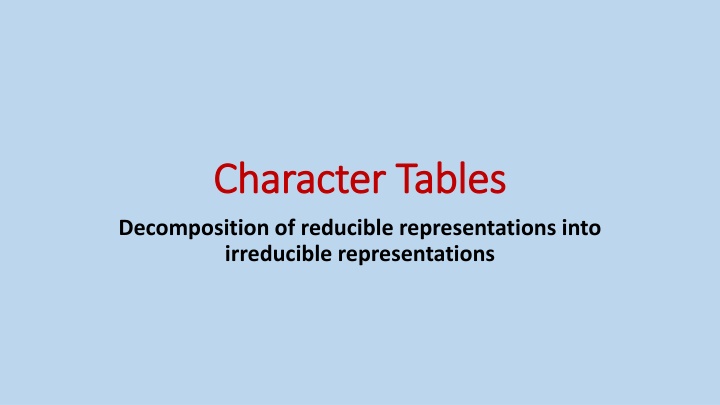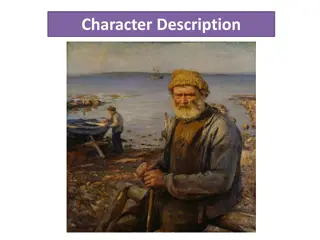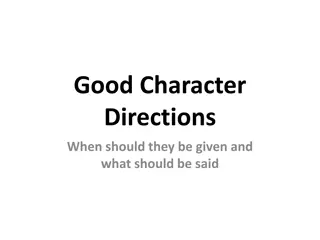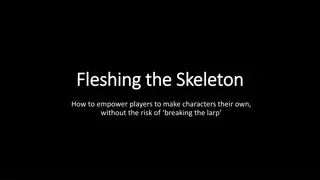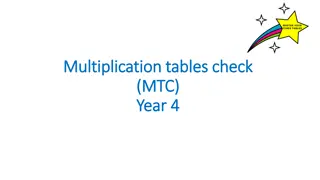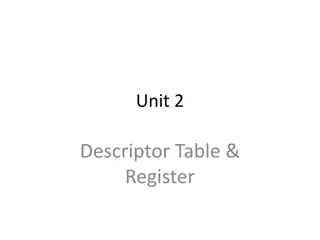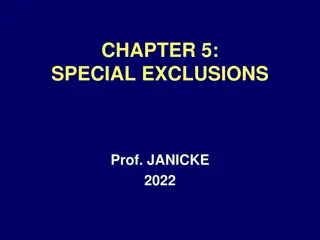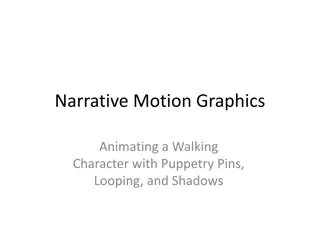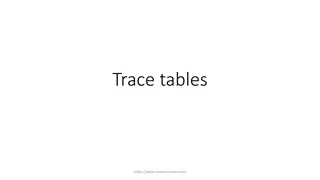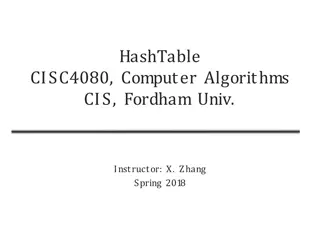Character Tables
This content discusses the decomposition of reducible representations into irreducible representations using Character Tables. It explains the general form of Character Tables, Mulliken symbols for labeling representations, and provides insights into the relationship between symmetry operations and mathematical functions. The Mulliken symbols further classify the irreducible representations based on their symmetry properties, providing a comprehensive guide for understanding the representations in different point groups.
Download Presentation

Please find below an Image/Link to download the presentation.
The content on the website is provided AS IS for your information and personal use only. It may not be sold, licensed, or shared on other websites without obtaining consent from the author.If you encounter any issues during the download, it is possible that the publisher has removed the file from their server.
You are allowed to download the files provided on this website for personal or commercial use, subject to the condition that they are used lawfully. All files are the property of their respective owners.
The content on the website is provided AS IS for your information and personal use only. It may not be sold, licensed, or shared on other websites without obtaining consent from the author.
E N D
Presentation Transcript
Character Tables Character Tables Decomposition of reducible representations into irreducible representations
General form of Character Tables: (b) (a) (f) (c) (d) (e) (a) Gives the Schonflies symbol for the point group. (b) Lists the symmetry operations (by class) for that group. (c) Lists the characters, for all irreducible representations for each class of operation. (d) Shows the irreducible representation for which the six vectors Tx, Ty, Tz, and Rx, Ry, Rz, provide the basis. (e) Shows how functions that are binary combinations of x,y,z (xy or z2) provide bases for certain irreducible representation.(Raman d orbitals) (f) List conventional symbols for irreducible representations: Mulliken symbols Page 2
Mulliken symbols: Labelling All one dimensional irreducible representations are labelled A or B. All two dimensional irreducible representations are labelled E. (Not to be confused with Identity element) All three dimensional representations are labelled T. For linear point groups one dimensional representations are given the symbol with two and three dimensional representations being and Page 3
Mulliken symbols: Labelling 1) A one dimensional irreducible representation is labelled A if it is symmetric with respect to rotation about the highest order axis Cn. (Symmetric means that = + 1 for the operation.) If it is anti-symmetric with respect to the operation = - 1 and it is labelled B. 2) A subscript 1 is given if the irreducible representation is symmetric with respect to rotation about a C2 axis perpendicular to Cn or (in the absence of such an axis) to reflection in a vplane. An anti-symmetric representation is given the subscript 2. For linear point groups symmetry with respect to s is indicated by a superscript + (symmetric) or (anti-symmetric) Page 4
Mulliken symbols: Labelling 3) Subscripts g (gerade) and u (ungerade) are given to irreducible representations That are symmetric and anti-symmetric respectively, with respect to inversion at a centre of symmetry. 4) Superscripts and are given to irreducible representations that are symmetric and anti-symmetric respectively with respect o reflection in a h plane. Note: Points 1) and 2) apply to one-dimensional representations only. Points 3) and 4) apply equally to one-, two-, and three- dimensional representations. Page 5
Character Table (C2v) functions. They represent mathematical functions such as orbitals, rotations, etc. The functions to the right are called basis
The px orbital atom of a molecule with C2v symmetry is rotated about the C2 axis, the orbital is reversed, so the character will be -1. If a px orbital on the central
The px orbital rotated about the C2 axis, the orbital is reversed, so the character will be -1. If a px orbital on the central atom of a molecule with C2v symmetry is
The px orbital atom of a molecule with C2v symmetry is reflected in the yz plane, the orbital is also reversed, and the character will be -1. If a px orbital on the central
The px orbital reflected in the yz plane, the orbital is also reversed, and the character will be -1. If a px orbital on the central atom of a molecule with C2v symmetry is
The px orbital reflected in the xz plane, the orbital is unchanged, so the character is +1. If a px orbital on the central atom of a molecule with C2v symmetry is
Character Table Representations 1. Characters of +1 indicate that the basis function is unchanged by the symmetry operation. 2. Characters of -1 indicate that the basis function is reversed by the symmetry operation. 3. Characters of 0 indicate that the basis function undergoes a more complicated change.
Character Table Representations 1. An A representation indicates that the functions are symmetric with respect to rotation about the principal axis of rotation. 2. B representations are asymmetric with respect to rotation about the principal axis. 3. E representations are doubly degenerate. 4. T representations are triply degenerate. 5. Subscrips u and g indicate asymmetric (ungerade) or symmetric (gerade) with respect to a center of inversion.
Symmetry of orbitals and functions i 6 S4 3 h 6 d Oh E 8 C3 6 C2 6 C4 3 C2 (C42) 1 1 2 8 S6 x2 + y2 + z2 A1g A2g Eg 1 1 2 1 1 -1 1 -1 0 1 -1 0 1 1 2 1 -1 0 1 1 -1 1 1 2 1 -1 0 (2z2 - x2 - y2, x2 - y2) (Rx, Ry, Rz) T1g 3 0 -1 1 -1 3 1 0 -1 -1 (xz, yz, xy) T2g 3 0 1 -1 -1 3 -1 0 -1 1 A1u 1 1 1 1 1 -1 -1 -1 -1 -1 A2u 1 1 -1 -1 1 -1 1 -1 -1 1 Eu 2 -1 0 0 2 -2 0 1 -2 0 (x, y, z) T1u 3 0 -1 1 -1 -3 -1 0 1 1 T2u 3 0 1 -1 -1 -3 1 0 1 -1 More notes about symmetry labels and characters: - T indicates that the representation is triply-degenerate this means that the functions grouped in parentheses must be treated as a threesome and can not be considered individually. -The subscripts g (gerade) and u (ungerade) in the symmetry representation label indicates symmetric or anti-symmetric with respect to the inversion center, i.
Conversion of Reducible Representations Conversion of Reducible Representations into Irreducible Representations into Irreducible Representations 21
Generating Reducible Representations Summarising we get that 3n for this molecule is: (xz) (yz) C2v 3n E C2 +9 -1 +1 3 To reduce this we need the character table for the point groups (xz) (yz) E C2 C2v A1 A2 B1 +1 +1 +1 +1 +1 -1 +1 -1 +1 +1 -1 -1 Tz Rz Tx ,Rx x2, y2, z2 xy xz B2 +1 -1 -1 +1 Ty ,Ry yz Page 22
Reducing Reducible Representations 1 ( ) R = . ( ). a n R We need to use the reduction formula: p R p g R Where apis the number of times the irreducible representation, p, occurs in any reducible representation. g is the number of symmetry operations in the group (R)is character of the reducible representation p(R)is character of the irreducible representation nRis the number of operations in the class Page 23
(xz) (yz) 1E 1C2 C2 v A1 A2 B1 For C2v ; g = 4 and nR = 1 for all operations +1 +1 +1 +1 +1 -1 +1 -1 +1 +1 -1 -1 Tz Rz Tx ,Rx x2, y2, z2 xy xz B2 +1 -1 -1 +1 Ty ,Ry (yz) yz (xz) C2v 3n E C2 +9 -1 +1 3 1 ( ) R = . ( ). a n R p R p g R aA1 = (1/4)[ ( 1x9x1) + (1x-1x1) + (1x1x1) + (1x3x1)] = (12/4) =3 Page 24
(xz) (yz) 1 C2v 3n E C2 ( ) R = . ( ). a n R p R p g +9 -1 +1 3 R aA1 = (1/4)[ ( 1x9x1) + (1x-1x1) + (1x1x1) + (1x3x1)] = (12/4) =3 aA2 = (1/4)[ ( 1x9x1) + (1x-1x1) + (1x1x-1) + (1x3x-1)] = (4/4) =1 aB1 = (1/4)[ ( 1x9x1) + (1x-1x-1) + (1x1x1) + (1x3x-1)] = (8/4) =2 aB2 = (1/4)[ ( 1x9x1) + (1x-1x-1) + (1x1x-1) + (1x3x1)] = (12/4) =3 3n = 3A1 + A2 + 2B1 + 3B2 Page 25
